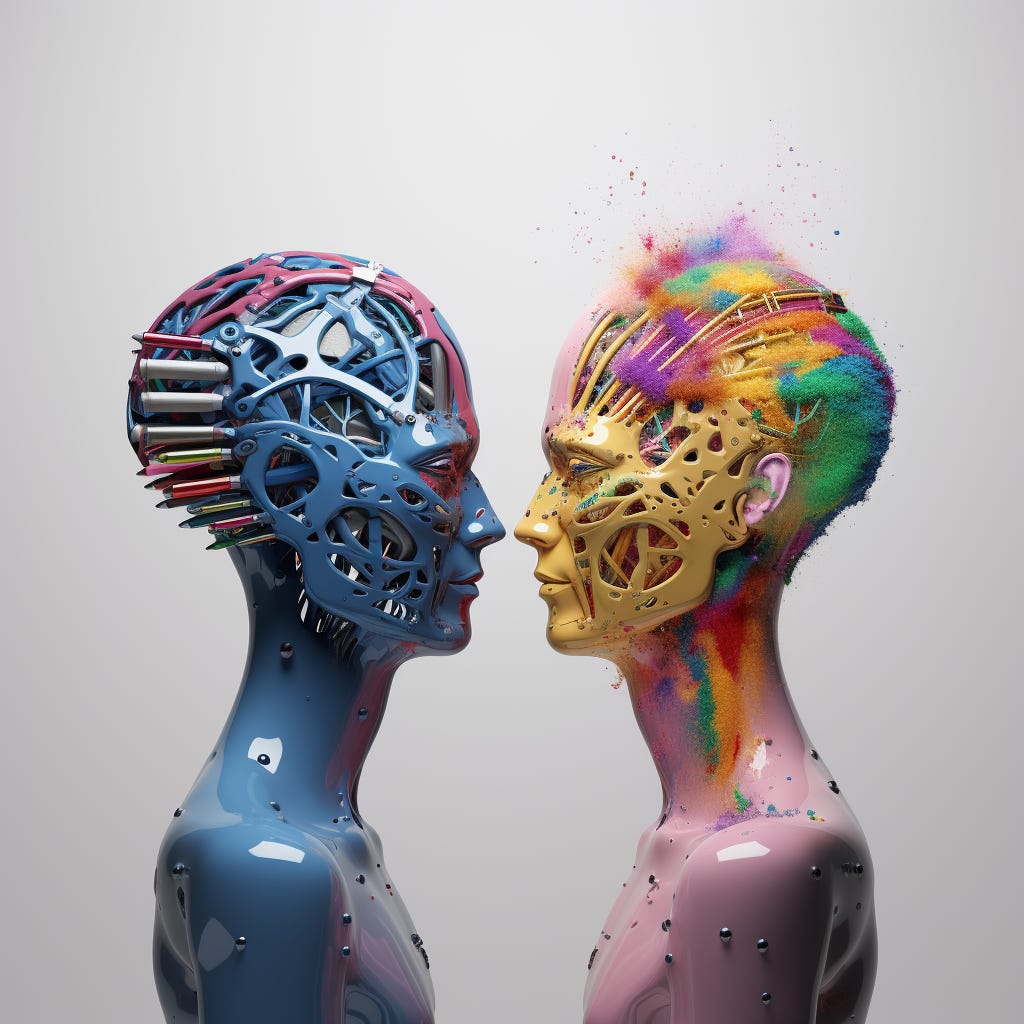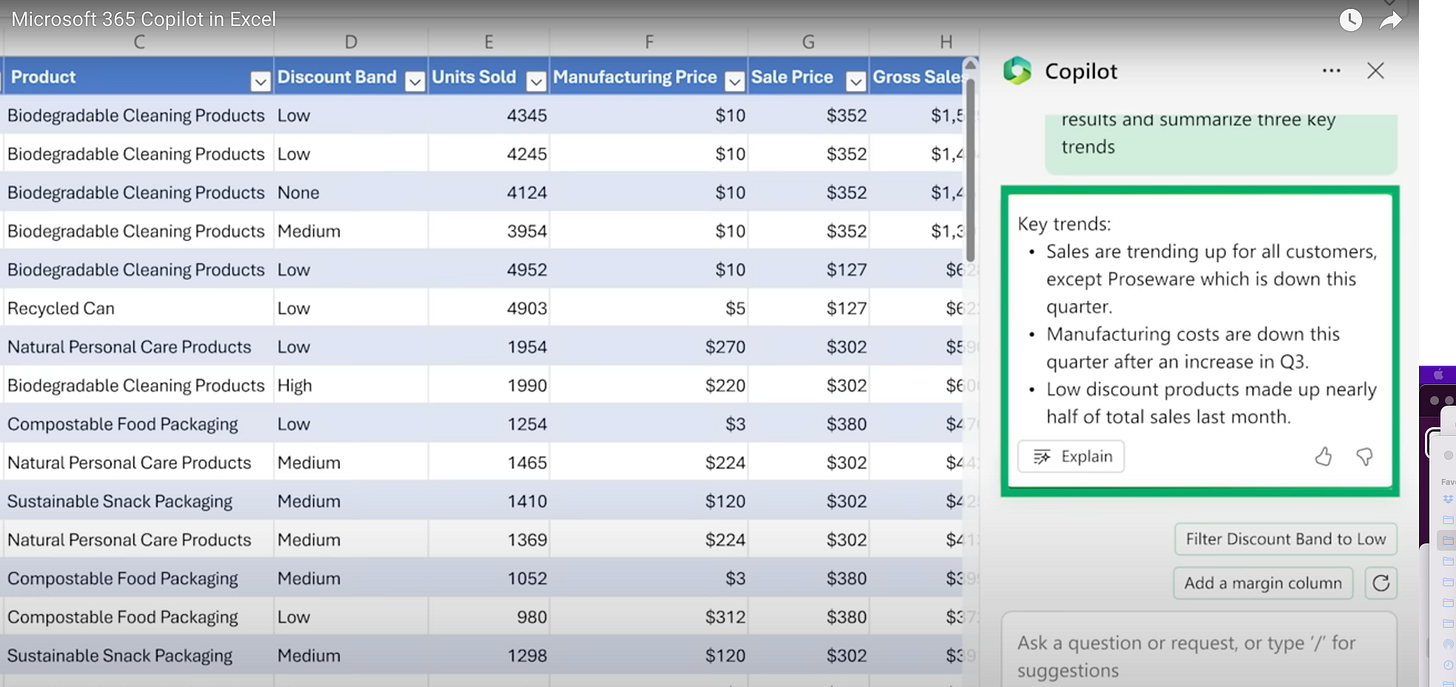If as Steve Jobs believed, “computers are like a bicycle for the mind”, then AI is like a jetpack. And it’s no surprise that, when you remove the risk of falling out of the sky, hundreds of millions of us are enthusiastically strapping on our metaphorical jetpacks.
Yes, the jetpack analogy was suggested by ChatGPT.
But (and now we’re back into human insight territory), the more I thought about “AI as a jetpack for the mind”, the more I realised that it captures something profound about how to think about AI.
To return to our analogy, there are two reasons to use a jetpack. One is to get from A to B exponentially faster. The other is to have fun – to defy gravity and soar high into the sky.
Similarly, when it comes to the question ‘what’s our AI strategy?’ (and is there an exec in the world who isn’t being asked this?), one powerful initial framing is to think:
1) Are you augmenting human creativity and/or intelligence, and enhancing people’s experiences?
2) Or are you accelerating human productivity, by automating or eliminating mundane tasks?
Of course, this isn’t the only question to ask yourself, especially in these early days where AI’s inputs and outputs have huge issues with bias, hallucinations and misinformation. Platforms and tools rightly face tough questions around trust and transparency. But that’s for another edition…and my assumption (naive hope?!) is that these issues get ‘solved’ and made largely invisible to the end user, over time.
The best way to illustrate the “augment or accelerate” framework is by seeing it action. Let’s dive into just a handful of the mind-blowing demos, tools and stories from the last few weeks.
Part 1: Augmented creativity
Can you remember the quaint days, way back in perhaps 2021, when the vast majority of ‘creatives’ viewed their careers as a distant target for automation?
As writers, myself and Rohit have experienced this paradigm shift as keenly as anyone – indeed we went from writing about AI, to writing with AI while working on our new book, The Future Normal. Yet our current use of AI tools – copilots that help us brainstorm, expand, review and challenge our still human-generated words – is nothing compared to some of the epic leaps AI is enabling people to make in other creative areas.
Midjourney: Image Generator gets more accessible.
Users can now use the /describe feature to generate a detailed prompt from an image (making it easier to tweak and remix); they can also use the tool’s new ‘permutations’ feature to generate multiple variants from a single command. Just don’t mention the Pope’s puffer jacket…





AI Taylor Swift takes over TikTok
The fear of deepfakes is well justified. It isn’t hard to imagine how faked ‘news’ photos or videos having serious real world consequences. But there’s a lighter, more creative side to synthetic media (to give deepfakes their more corporate name), as shown by Swifties’ embrace of AI tools that allow them to create believable fictional clips of Taylor Swift saying, well, anything – “I couldn’t give less of a f**k about my tickets being over a thousand dollars; I don’t perform for poor b*tches”. 🫣
Memecam: automagical memes
Amid the angst over the existential risk of a super-intelligent AGI wiping out humanity, it seems beyond trivial to celebrate Memecam.dk. But it blows my mind that we have not just blown past the Turing test in recent months, and not just in text chat. Now you can have text memes automatically overlaid on any image you capture, in seconds. And they are actually funny (if reliant on some fairly base humour around kids & dads … yup, this app was a big part of my Easter weekend :)



Augmented intelligence
Creativity is one dimension where AI is extending people’s capabilities. Intelligence is another.
Apollo: voice- and audio-enabled ChatGPT
Can’t or don’t want to type? On the go so can’t read ChatGPT’s responses? Then Apollo’s realtime audio knowledge app will be just what you’re looking for. I’m skeptical that this will become commonplace, given that reading (or more accurately, skimming information visually) is a far more efficient way to consume information. But there will definitely be groups who will embrace this, such as the visually impaired or drivers.

PWC: rolls out an AI copilot to its legal teams
PWC employs over 4,000 legal professionals in 100+ countries. Now they will receive insights and recommendations from a customized AI platform, thanks to a partnership with startup Harvey. The company stresses that “all outputs will be overseen and reviewed by PwC professionals.” For now…
Duolingo: personalized translation assistance.
Given that translation will soon become ubiquitous, I remain fascinated that one of the first commercial use cases of GPT-4 was a language learning ‘AI coach’ that offers dynamic feedback on where and why learners are going wrong. Read more about generative AI’s non-obvious winners and losers here.
Character.ai: a chatbot for everyone
Imagine if you could chat with anyone, including those who are long-dead and/or celebrities? Character.ai lets you do just that, so you can get feedback on your new product from Steve Jobs, for example. It’s designed to be entertaining rather than overly serious, but it still offers a richer, more personal approach than simply reading about people in books or learning from them via video.
The Future Normal chatbot
It’s the chatbot you’ve been waiting for ;) Forget the generic ChatGPT4, you can now chat to The Future Normal, thanks to a startup called Berri.ai. You can ask it to summarize specific chapters, or even try asking it how your company could tap into the book’s big ideas.

Part 2: Accelerating Human Productivity
From AI assistants to coding copilots, there will be endless tools that automate and accelerate daily tasks. Scheduling meetings. Summarising documents. Sending emails. Drafting reports. Every mundane or repetitive process will soon be handled by AI.
OpenAI: Plugins allows ChatGPT to perform tasks
One of the (many!) big news stories of recent weeks – select developers can now build plugins, opening up a variety of new use cases, ranging from browsing product catalogs to ordering food. For example, the Wolfram Alpha plugin enables users to answer significantly more complex questions, including those that require calculation. It’s well worth diving into this excellent overview from Stephen Wolfram to get a sense of how powerful these plugins will be.

AutoGPT: the path to AGI (Artificial General Intelligence)?
Just as we tried to get our heads around GPT plugins, along came a number of AutoGPT projects. Essentially, given an objective, these models can plan and execute multi-step processes in order to achieve the initial goal. In theory, as they improve this could mean near infinite amounts of autonomous, AI-directed activity.
Nuance: generates patient notes instantly
The Microsoft-owned Nuance is launching DAX Express, a service to reduce clinicians’ administrative burdens. It listens to a consultation, and then automatically generates a draft of clinical notes after a patient’s visit. Physicians review and can make edits to the notes before signing them off for entry into the patient’s electronic health record.
Do Not Pay - automated refunds & consumer rights
When Josh Browder was 19, he created a rudimentary chatbot which generated legally robust letters for people to challenge parking fines. His ‘robot lawyer’ went viral, and he ended up raising $10 milliion to ‘fiight bureauucracy for consumers. Now, Do Not Pay is using GPT4 to automate lawsuits against robocallers, cancel gym memberships and find unclaimed government refunds for people.
Conclusion
Hybrid thinking: accelerating and augmenting
In reality, most businesses won’t fall neatly on one side or the other. You will have to unpack your products and the multiple journeys customers take through them in order to get super granular about exactly where you should look to accelerate productivity and where you should augment creativity and intelligence. Many products will do both.
Microsoft: Copilot for Office 365
Who’d have thought even 6 months ago that MS Office, the stalwart of the late 90s desktop era, would soon be causing the Google Docs generation to try and recover their Microsoft login details?! While still not widely available yet, the teasers for Microsoft’s copilot promise to transform the world of white collar work, with a mix of productivity automations (meeting notes, email thread summaries, real-time video conference translation, etc) and skill enhancers (natural language spreadsheet commands, creativity-boosting text and image generators). Let’s hope these are a big up from the infamous Clippy ;)
Where next?
When AI is moving this fast, making long (or even short) term predictions about its capabilities and impacts is well beyond this newsletter. All you can do is understand your customers, and their deep-rooted needs and wants. Focus on what won’t change as much as on what will change.
Indeed you can be sure that in 10 years time, people will still demand things ever faster and, at the same time, they will aspire to be smarter and more creative. Every organization in the world has moments where they speak to these two fundamental needs. AI is transforming both. Time to build…
What Is The Future Normal For Your Business?
My new book, The Future Normal: How We Will Live, Work & Thrive In The Next Decade, explores 30 trends, from continuous glucose monitoring to job sharing.
I also give inspiring, actionable presentations that help your team spot and seize emerging opportunities.
Get in touch if you'd like to discuss an upcoming event or project.
Or, sit back and enjoy the keynote that myself & Rohit Bhargava gave at SXSW to launch the book:
Thanks for reading,







